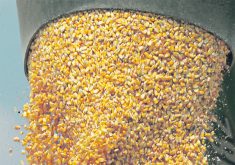Jeffrey Kennedy expects to see soybean prices climb higher to reach near $9 US per bushel.
But the analyst does not recommend that traders buy their way into the crop. To him, this is a time when discretion is the better part of valour.
“Now is not the time to get cocky or arrogant or be throwing a lot of money around,” said Kennedy, who is the futures markets analyst with Elliott Wave International.
“Now is the time to be trade smart, analysis smart.”
Read Also

Chinese, Indian tariffs take toll on pea prices
The disruption of pea exports from Canada’s largest customers will likely result in slow pea exports for the remainder of the crop year.
Kennedy thinks a smart move is to begin locking in the profits made on the recent rally in soybean prices, rather than look at squeezing out every penny of potential gain remaining in the market.
He thinks soybeans can climb again, probably to $8.88 per bu. on the Chicago Board of Trade November contract, but will then decline to about $7.50.
“I think the risk is to the downside.”
He also expects wheat will top out soon between $7.50 and $8, before dropping back to around $6.
Soybeans are particularly risky now, Kennedy said. The best-case scenario is one of a correction back to $7.50. But there is a danger that soybeans could fall back to their February 2005 lows, when the price touched $5.
“We’re at a very key juncture in regards to soybeans,” said Kennedy.
“We’re at a crossroads. The market really hasn’t shown its hand.”
Kennedy is a technical analyst, relying on price chart analysis to show him the most likely direction of market prices.
His price forecasts are based on Elliott Wave analysis, which says the market moves in a predictable manner of five waves upward followed by three waves down.
Within the upward and downward movements, there are regular and predictable corrections.
It’s an arcane form of analysis that has fervent followers and numerous detractors, but to Kennedy, it’s all about predictive accuracy. He believes Elliott Wave analysis is better than other forms of technical analysis.
The key juncture Kennedy sees in soybean prices will follow his expected selloff to $7.50.
If it levels off, then it will be preparing for another “impulse wave” movement higher, and the price decline will have been just a correction in a long-term bull market in soybeans.
This is what Kennedy expects to see.
But if soybeans fall to $7, then an alternative scenario comes into play: soybeans have concluded their long-term move higher and the decline will mark the beginning of a one to three year bear market for soybeans.
The depth of the decline in soybean prices that should follow its $8.88 peak, a peak he expects to occur within days, will flag which scenario is most likely.
“Right now is a very pivotal time. The next one to three months is going to be very critical for the soybean market because it should determine the direction prices will take for the next one to three years,” said Kennedy.
While he’s a believer in the Elliott Wave approach, he doesn’t claim that the charts always make it easy. A key part of the theory is that analysts must look at alternate counts in case they have misread the charts.
That’s what Kennedy is doing with his two scenarios for soybean prices. The most likely wave count leads him to expect a fallback to $7.50, but his analytical discipline forces him to propose an alternative, which forecasts a long bear market.
Having such divergent views on long-term market direction may annoy some who want a simple, definite prediction.
But Kennedy said he isn’t trying to be a visionary who’s right on one big perfect prediction.
He would prefer to be humble and admit the lack of clarity in the market now, while highlighting the short-term downside risk.
“I’m a trader at heart. I’m into it for the money. If the next move is to the downside, I don’t want to miss that move because I’m arrogant or I’m so married to my long-term wave count because the wave count I’ve been working with for two years has been going according to plan,” he said.















